十三章低能电子衍射讲义
- 格式:ppt
- 大小:458.50 KB
- 文档页数:24
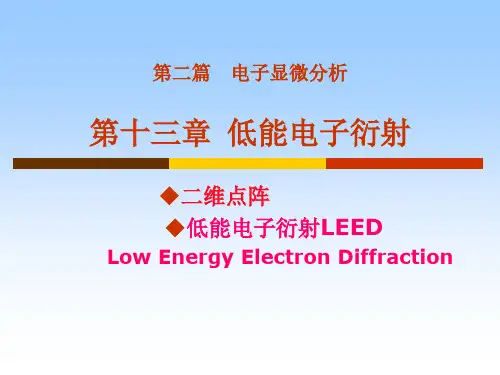
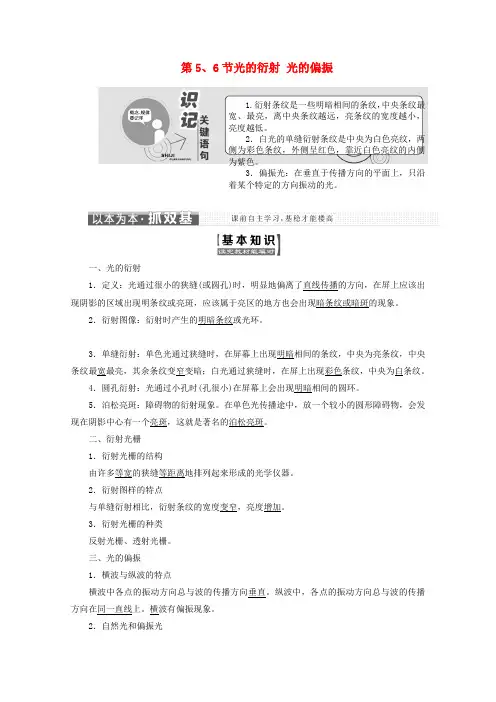
第5、6节光的衍射光的偏振1.衍射条纹是一些明暗相间的条纹,中央条纹最宽、最亮,离中央条纹越远,亮条纹的宽度越小,亮度越低。
2.白光的单缝衍射条纹是中央为白色亮纹,两侧为彩色条纹,外侧呈红色,靠近白色亮纹的内侧为紫色。
3.偏振光:在垂直于传播方向的平面上,只沿着某个特定的方向振动的光。
一、光的衍射1.定义:光通过很小的狭缝(或圆孔)时,明显地偏离了直线传播的方向,在屏上应该出现阴影的区域出现明条纹或亮斑,应该属于亮区的地方也会出现暗条纹或暗斑的现象。
2.衍射图像:衍射时产生的明暗条纹或光环。
3.单缝衍射:单色光通过狭缝时,在屏幕上出现明暗相间的条纹,中央为亮条纹,中央条纹最宽最亮,其余条纹变窄变暗;白光通过狭缝时,在屏上出现彩色条纹,中央为白条纹。
4.圆孔衍射:光通过小孔时(孔很小)在屏幕上会出现明暗相间的圆环。
5.泊松亮斑:障碍物的衍射现象。
在单色光传播途中,放一个较小的圆形障碍物,会发现在阴影中心有一个亮斑,这就是著名的泊松亮斑。
二、衍射光栅1.衍射光栅的结构由许多等宽的狭缝等距离地排列起来形成的光学仪器。
2.衍射图样的特点与单缝衍射相比,衍射条纹的宽度变窄,亮度增加。
3.衍射光栅的种类反射光栅、透射光栅。
三、光的偏振1.横波与纵波的特点横波中各点的振动方向总与波的传播方向垂直。
纵波中,各点的振动方向总与波的传播方向在同一直线上。
横波有偏振现象。
2.自然光和偏振光(1)自然光:太阳、电灯等普通光源发出的光,包含着在垂直于传播方向上沿一切方向振动的光,沿着各个方向振动的光波的强度都相同。
(2)偏振光:在垂直于传播方向的平面上,只沿着某个特定的方向振动的光。
3.光的偏振1.自主思考——判一判(1)白光通过盛水的玻璃杯,在适当的角度,可看到彩色光,是光的衍射现象。
(×)(2)菜汤上的油花呈现彩色,是光的折射现象。
(×)(3)用两支圆柱形铅笔并在一起,形成一个狭缝,使狭缝平行于日光灯,会看到彩色的衍射条纹。
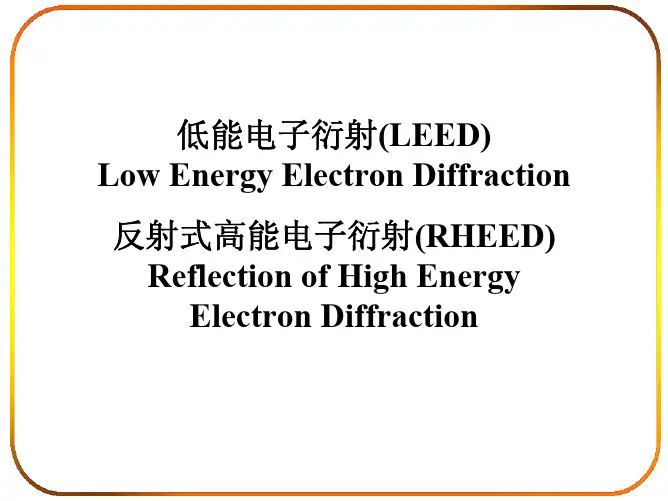

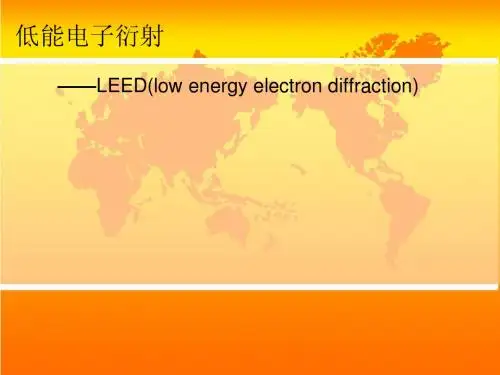

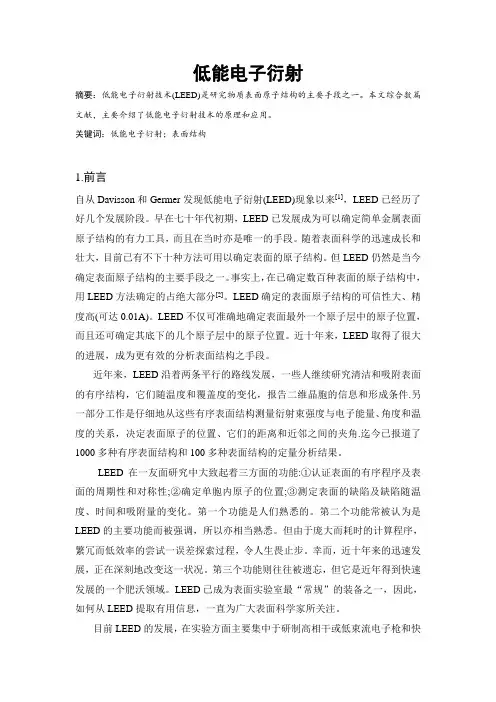
低能电子衍射摘要:低能电子衍射技术(LEED)是研究物质表面原子结构的主要手段之一。
本文综合数篇文献,主要介绍了低能电子衍射技术的原理和应用。
关键词:低能电子衍射;表面结构1.前言自从Davisson和Germer发现低能电子衍射(LEED)现象以来[1],LEED已经历了好几个发展阶段。
早在七十年代初期,LEED已发展成为可以确定简单金属表面原子结构的有力工具,而且在当时亦是唯一的手段。
随着表面科学的迅速成长和壮大,目前已有不下十种方法可用以确定表面的原子结构。
但LEED仍然是当今确定表面原子结构的主要手段之一。
事实上,在已确定数百种表面的原子结构中,用LEED方法确定的占绝大部分[2]。
LEED确定的表面原子结构的可信性大、精度高(可达0.01A)。
LEED不仅可准确地确定表面最外一个原子层中的原子位置,而且还可确定其底下的几个原子层中的原子位置。
近十年来,LEED取得了很大的进展,成为更有效的分析表面结构之手段。
近年来,LEED沿着两条平行的路线发展,一些人继续研究清洁和吸附表面的有序结构,它们随温度和覆盖度的变化,报告二维晶胞的信息和形成条件.另一部分工作是仔细地从这些有序表面结构测量衍射束强度与电子能量、角度和温度的关系,决定表面原子的位置、它们的距离和近邻之间的夹角.迄今已报道了1000多种有序表面结构和100多种表面结构的定量分析结果。
LEED在一友面研究中大致起着三方面的功能:①认证表面的有序程序及表面的周期性和对称性;②确定单胞内原子的位置;③测定表面的缺陷及缺陷随温度、时间和吸附量的变化。
第一个功能是人们熟悉的。
第二个功能常被认为是LEED的主要功能而被强调,所以亦相当熟悉。
但由于庞大而耗时的计算程序,繁冗而低效率的尝试一误差探索过程,令人生畏止步。
幸而,近十年来的迅速发展,正在深刻地改变这一状况。
第三个功能则往往被遗忘,但它是近年得到快速发展的一个肥沃领域。
LEED已成为表面实验室最“常规”的装备之一,因此,如何从LEED提取有用信息,一直为广大表面科学家所关注。
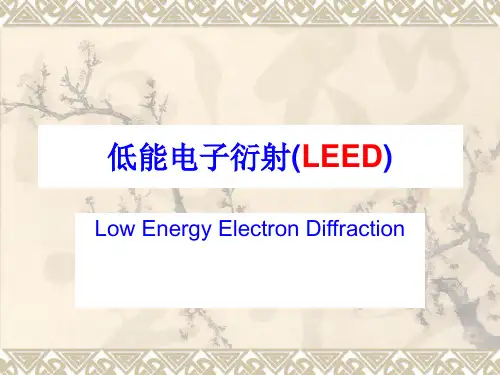
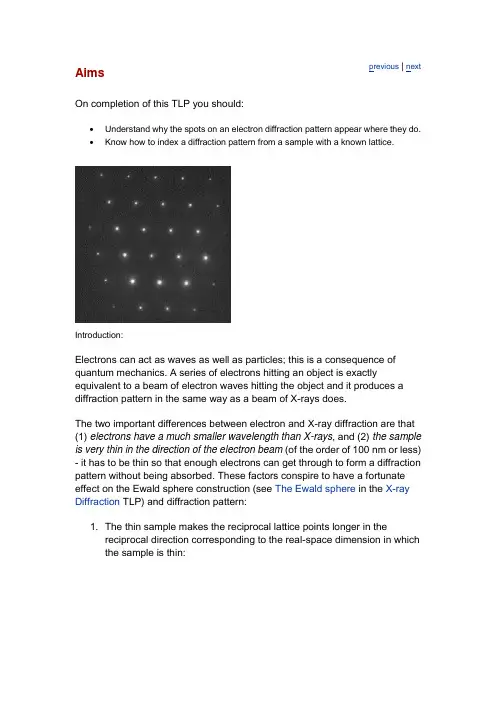
Aims previous | next On completion of this TLP you should:∙Understand why the spots on an electron diffraction pattern appear where they do.∙Know how to index a diffraction pattern from a sample with a known lattice.Introduction:Electrons can act as waves as well as particles; this is a consequence of quantum mechanics. A series of electrons hitting an object is exactly equivalent to a beam of electron waves hitting the object and it produces a diffraction pattern in the same way as a beam of X-rays does.The two important differences between electron and X-ray diffraction are that (1) electrons have a much smaller wavelength than X-rays, and (2) the sample is very thin in the direction of the electron beam (of the order of 100 nm or less) - it has to be thin so that enough electrons can get through to form a diffraction pattern without being absorbed. These factors conspire to have a fortunate effect on the Ewald sphere construction (see The Ewald sphere in the X-ray Diffraction TLP) and diffraction pattern:1. The thin sample makes the reciprocal lattice points longer in thereciprocal direction corresponding to the real-space dimension in which the sample is thin:It should be noted that there is not necessarily always a particular plane oriented like this. However, it is usual for identification of crystallinephases in a sample to orient the sample so that the electron beam isparallel to a low index lattice direction, as this makes the electrondiffraction pattern easier to interpret.2. The small electron wavelength makes the radius of the Ewald spherevery large (recall its radius is 1/λ). The small electron wavelength alsomakes the diffraction angles θ small (1-2°); this can be seen bysubstituting a wavelength of 2.51 x 10-12 m into the Bragg equation (see The Bragg law in the X-ray Diffraction TLP).These make the Ewald sphere diagram look like this so that whole layers of the reciprocal lattice end up projected onto the film or screen:Note that the large (strong) spot in the middle is the straight-through beam (the beam which has passed through the sample without diffracting). This always has the index 000.Caution 1: systematic (kinetic) absences appear in electron diffraction patterns just as in X-ray diffraction patterns, for the same reason: the various features of the lattice or motif diffract electrons in the same direction but the phase factors from the various features cancel, leaving an absence.Caution 2: sometimes where there should be a systematic absence, the spot appears to be still there. This is because of the strong interaction between electrons and atoms: there is a small but significant probability that an electron will be diffracted twice, from two planes one after another - i.e. in two different reciprocal lattice directions one after another. These two directions can add up so that the twice-diffracted electron may arrive at a position in reciprocal space where there is a systematic absence. As an example, the diagram below is a schematic of the [011] electron diffraction pattern of silicon: the 200 type reflections are systematically absent. The intensity at the 200 reflections is caused by double diffraction (arising from the addition of the two reciprocal lattice vectors shown). Thus, in words, intensity can occur in the 200 reflectionfrom, firstly, diffraction from the 11planes, followed by, secondly, difraction by the 1 1 planes as the electron wave passes throught the specimen.Mathematics relating the real space to the electron diffraction patternThe distance, r hkl , on the pattern between the spot hkl and the spot 000 is related to the interplanar spacing between the hkl planes of atoms, d hkl , bythe following equation:(Derivation )where L is the distance between the sample and the film/screen.We can therefore say that the diffraction pattern is a projection of thereciprocal lattice with projection factor L , because reciprocal lattice vectors have length 1/d hkl .Relation 2Since the diffraction pattern is a projection of the reciprocal lattice, the angle between the lines joining spots h 1k 1l 1 and h 2k 2l 2 to spot 000 is the same as the angle between the reciprocal lattice vectors [h 1k 1l 1]* and [h 2k 2l 2]*. This is also equal to the angle between the (h 1k 1l 1) and (h 2k 2l 2) planes, orequivalently the angle between the normals to the (h 1k 1l 1) and (h 2k 2l 2)planes. This angle is θin the diagram below.Using these two relations between the diffraction pattern and the reciprocal lattice, we are now able to index the electron diffraction pattern from a specimen of a known crystal structure.The two pages linked to here refer only to indexing the central region of the diffraction pattern - the rest will be dealt with later.back Indexing with the orientation of the electron beamknownFrom the Ewald sphere diagram, we know that the zero order Laue zone (ZOLZ) contains reflections hkl where hu + kv + lw= 0 (the Weiss zone law). This ZOLZ can be identified by finding two reciprocal lattice vectors in theZOLZ. Suppose these two reciprocal lattice vectors are h1a* + k1b* + l1c* and h2a* + k2b* + l2c*. Then we knowh1u + k1v + l1w= 0andh2u + k2v + l2w= 0and that the angle between these reciprocal lattice vectors is the angle between the h1k1l1 and h2k2l2 planes.Other reflections in the electron diffraction pattern can then be deduced from simple vector addition, with the proviso that the indices of the reciprocal lattice vectors are integers and that they are not forbidden by the lattice. The pattern can then be built up manually or by computer.Example of indexing with a known electron beam orientationbackSuppose the material under examination is copper, and suppose the electron beam direction is [211]. Copper has a cubic close packed structure with a lattice parameter, a, of 0.361 nm. Allowed reflections must have h,k,l either all even or all odd. Thus the planes with the highest interplanar spacings (and hence those that give rise to reflections with the smallest r hkl values) are {111}, {200}, {220}, {311}, {222}, etc.Looking at the {111} planes, it is apparent that the Weiss zone law is obeyedfor (11) when [uvw] =[211]. Hence 11 is a possible reciprocal latticevector.No {200} plane will obey the Weiss zone law for [uvw] = [211], but of the{220} planes it is apparent that (02) will. Hence 02is a second possible reciprocal lattice vector.The angle between the 11 and 02reciprocal lattice vectors is 90° - the dot product of these two reciprocal lattice vectors is zero. The ratio of thelengths of these two reciprocal lattice vectors is . These are the two shortest reciprocal lattice vectors in the [211] electron diffraction pattern. Thus the pattern looks like:back Indexing with the orientation of the electron beamunknownIf we do not know the beam orientation, it is rather more difficult to find which reciprocal plane is the one projected down onto the film.One approach is to consult tables of angles and distance ratios for the low index reflections for the structure of the crystal we are imaging. Again, we will use copper as an example.Table of anglesThe angles in this table are the angles between the reciprocal lattice vectors given at the sides of the table in the appropriate row and column. Such aTable of distance ratiosThe dimensionless numbers in the central portion are the ratios of the 1/d hklexcluded. Thus for copper, which has an F lattice, the reflections are those with h ,k ,l all even or all odd.Now we pick two spots on the diffraction pattern and measure the angle between them and the ratio of their distances from the 000 spot - and see if they correspond to any of the values in the tables.View an exampleOnce we know for sure what two of the non-collinear dots are, we can index the rest of the pattern by vector addition.Example of indexing with an unknown electron beamorientationbackIf were 72.5° and we were to measure the ratio x/y and find it to benumerically equal to 1.66 then we could be reasonably convinced that the dot at Y could be labelled as the 200 spot, and the dot at X could be labelled as 113. In this case our predicted electron beam direction is in thedirection common to the 200 and 113 planes, i.e. [03]. This particular electron diffraction pattern has a central rectangular repeat. If this is correct, further spots on this diffraction pattern can be indexed in aself-consistent manner by vector addition.Laue zoneSo far we have been looking at the central region of the diffraction pattern. This is only a part of the total diffraction pattern. If we look again at the Ewald sphere construction, we have:We have been indexing the portion in the middle with the 000 spot in it. However, there are also areas of diffraction spots at the edges of the film, caused by the Ewald sphere intersecting points in an adjacent parallel plane containing reciprocal lattice points. (If the film was small or the camera length large it is possible that it did not catch these spots at the side, so that we sometimes only have the middle part.)These outlying parts of the diffraction pattern are called Higher Order Laue Zones (HOLZs). Each of the HOLZs can be described by an equation of the general formhu + kv + hw Nwhere:∙N is always an integer, and is called the order of the Laue zone.∙[uvw] is the direction of the incident electron beam.∙hkl are the co-ordinates of an allowed reflection in the N th order Laue zone.The middle part of the diffraction pattern, with 000 in it, is the zero order Laue zone (ZOLZ), because it comes from the plane for which N =0: an allowed reflection hkl in the ZOLZ is joined to the origin 000 by a reciprocal lattice vector that lies in the ZOLZ. For the ZOLZ the electron beam [uvw] and the allowed reflection hkl satisfy the Weiss zone law hu + kv + lw= 0. The next layer up has a value N =1, then N =2, and so on, as shown.From the geometry of the way in which the Ewald sphere intersects the HOLZs, the radius of the N th HOLZ ring, R n, in reciprocal space, is given to a very good approximation by the formulaassuming that the wavelength of the electrons is much less than the modulus |uvw| of the direction [uvw] in the crystal parallel to the electron beam direction. Thus, HOLZs are seen more easily at lower voltages (e.g. 100 kV rather than 300 kV) and when the electron beam is parallel to a relatively high index direction in a crystal.It is possible to index the reflections in the HOLZs on a diffraction pattern. Examples of such indexing are given in the book Transmission Electron Microscopy of Materials by D B Williams and C B Carter.Kikuchi lines previous | next Kikuchi lines often appear on electron diffraction patterns:An example of a "two-beam" electron diffraction pattern with a number of Kikuchi lines.A pair of Kikuchi lines is arrowed.[The term "two-beam" denotes the fact that the straight-through beam, 000, and one diffraction spot are both diffracting very strongly. The intensity of all spots in this electron diffraction pattern are significantly weaker by comparison with these two beams.](Click on image to view larger version)We will not learn to index the Kikuchi lines in this TLP. Instead, we will explain their origin and behaviour with the help of the following animation.Kikuchi lines are interesting because of what they do when the crystal is moved in the beam. Diffraction spots fade or become brighter when the crystal is rotated or tilted, but stay in the same places; the Kikuchi lines move across the screen.The difference in behaviour can be explained by the position of the effective source of the electrons that are Bragg-scattered to produce the two phenomena. The diffraction spots are produced directly from the electron beam, which either hits or misses the Bragg angle for each plane; so the spot is either present or absent depending on the orientation of the crystal. The source of the electrons that are Bragg-scattered to give Kikuchi lines is the set of inelastic scattering sites within the crystal. When the crystal is tilted the effective source of these inelastically scattered electrons is moved, but there are always still some electrons hitting a plane at the Bragg angle - they merely emerge at an angle different to the one that they did before the crystal was tilted.Using polycrystalline materials in the TEM previous | next Just as with X-rays, a completely isotropic fine-grained polycrystalline sample will give a diffraction pattern of concentric rings in the zero order Laue zone (ZOLZ), as the many small crystals at random orientations produce a continuous angular distribution of hkl spots at distance 1/d hkl from the 000 spot - a ring of radius 1/d hkl around the 000 spot for each allowed reflection. The rings are then indexed according to the order of allowed reflections within the ZOLZ.As the grain size increases, the rings within the diffraction pattern break up into discontinuous rings containing discrete reflections. If there is any texture (preferred orientation) within the specimen, arcs may be seen instead of complete rings.Convergent beam electron diffraction (CBED)previous | next When a convergent beam is used instead of a parallel beam of electrons, the rays converge to a point within the specimen and come out the other side inverted like a camera. However, we do not look at the inverted image; we look at the diffraction pattern, with the spots magnified:Depending on the camera length chosen, either the zero order Laue zone can be examined or the zero order Laue zone and higher order Laue zones. Two examples of CBED images are shown below. The symmetry seen is such patterns can be related to the space group symmetry of the specimen.Examples of CBED images:Diffraction pattern showing a zero order Laue zone with a mirror in the pattern as shown(Click on image to view larger version)Diffraction pattern showing a first order Lauezone(Click on image to view larger version)Using other methods in conjunction with electrondiffraction previous | next Electron diffraction is a powerful technique - but other techniques must be used with it to put the results in context. This is a brief synopsis of how other methods can be used to help.Optical imagingThis is a very important way of analysing a specimen. Using the naked eye and optical microscopes we can determine down to a point-to-point resolution limited by the wavelength of light how many phases there are and how they relate to one another. We can also infer what type of material they are likely to be and how they may have been processed.Chemical analysisA wide range of chemical techniques can be used to find out what components are present in the different phases and in what proportions. This will narrow the field of possible elements that we need to consider when analysing ourdiffraction results. These techniques range from simple chemical tests, through infrared spectroscopy of organic samples, to a wide variety of chemical characterisation techniques that can often be performed within thetransmission electron microscope.TEM imagingUsing the TEM to image the same area of sample that is being used toproduce the diffraction pattern is an invaluable technique:Nitrided surface layer of austenitic stainlesssteel(Click on image to view larger version)Diffraction pattern from nitrided surface layer of austenitic stainless steel (Click on image to view larger version) Using the image to verify that the double dots in the diffraction pattern arebeing caused by the two crystal structures either side of the twin boundary, we can index the pattern and determine the twin plane and the crystal structures either side of it.Summary previous | next In this teaching and learning package we have considered how electron diffraction patterns are formed in the transmission electron microscope. The principles of how to index spot electron diffraction patterns have been discussed in some detail. Although we have considered how to index electron diffraction patterns from relatively simple crystal structures toillustrate the basic principles, these principles are generic and can therefore be applied to any crystal structure. We have also considered other features of electron diffraction patterns such as the formation of Kikuchi lines, the formation of convergent beam electron diffraction patterns and theformation of higher index Laue zones.。
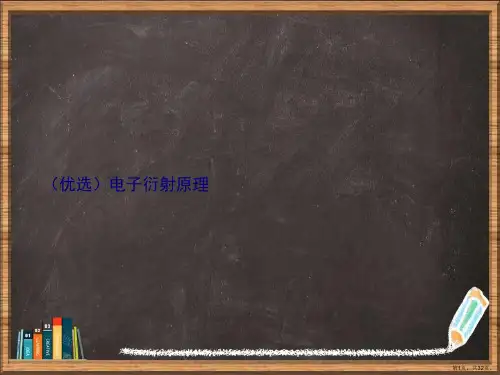
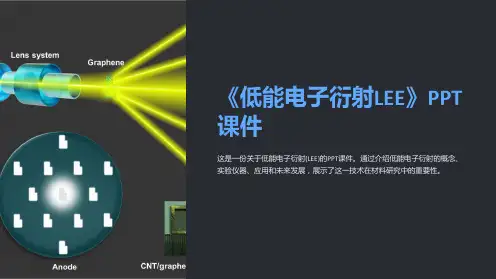
新开近代物理实验讲义之七 -----电子衍射实验讲义一 实验目的1 验证电子具有波动性的假设;2 了解电子衍射和电子衍射实验对物理学发展的意义;3 了解电子衍射在研究晶体结构中的应用; 二 实验仪器电子衍射,真空机组,复合真空计,数码相机,微机 三 实验原理 (一)、电子的波粒二象性波在传播过程中遇到障碍物时会绕过障碍物继续传播,在经典物理学中称为波的衍射,光在传播过程表现出波的衍射性,光还表现出干涉和偏振现象,表明光有波动性;光电效应揭示光与物质相互作用时表现出粒子性,其能量有一个不能连续分割的最小单元,即普朗克1900年首先作为一个基本假设提出来的普朗克关系hv E =E 为光子的能量,v 为光的频率,h 为普朗克常数,光具有波粒二象性。
电子在与电磁场相互作用时表现为粒子性,在另一些相互作用过程中是否会表现出波动性?德布罗意从光的波粒二象性得到启发,在1923-1924年间提出电子具有波粒二象性的假设,k p E==,ωE 为电子的能量,p为电子的动量,v πω2=为平面波的圆频率,k 为平面波的波矢量,π2/h = 为约化普朗克常数;波矢量的大小与波长λ的关系为λπ/2=k ,k p=称为德布罗意关系。
电子具有波粒二象性的假设,拉开了量子力学革命的序幕。
电子具有波动性假设的实验验证是电子的晶体衍射实验。
电子被电场加速后,电子的动能等于电子的电荷乘加速电压,即eV E k =考虑到高速运动的相对论效应,电子的动量)2(12mc E E cp k +=λ 由德布罗意关系得)2/1(222mc E E mc hck k +=λ真空中的光速s A c o/1099793.218⨯=,电子的静止质量26/10511.0c eV m ⨯=,普朗克常数eV A hc eVs h o4151023986.1,1013571.4⨯=⨯=-,当电子所受的加速电压为V 伏特,则电子的动能VeV E k =,电子的德布罗意波长o A V V)1089.41(1507-⨯-≈λ, (1)加速电压为100伏特,电子的德布罗意波长为oA 225.1。